by Lisa Di Tommaso | Jul 29, 2021 | Blog, Images, Photographic Archive
This blog comes from one of our dedicated team of volunteers who work in the library’s Photo Archive. David and his colleagues are the people who scan and provide context to the thousands of images that end up on the Photo Archive website ( http://photoarchive.morrablibrary.org.uk/ ), available for you to peruse and enjoy. David has given us a brilliant insight into his role as a volunteer, but also reveals his brilliant piece of detective work in identifying one particular image – an act of perseverance and detective work which would put Sherlock Holmes to shame….
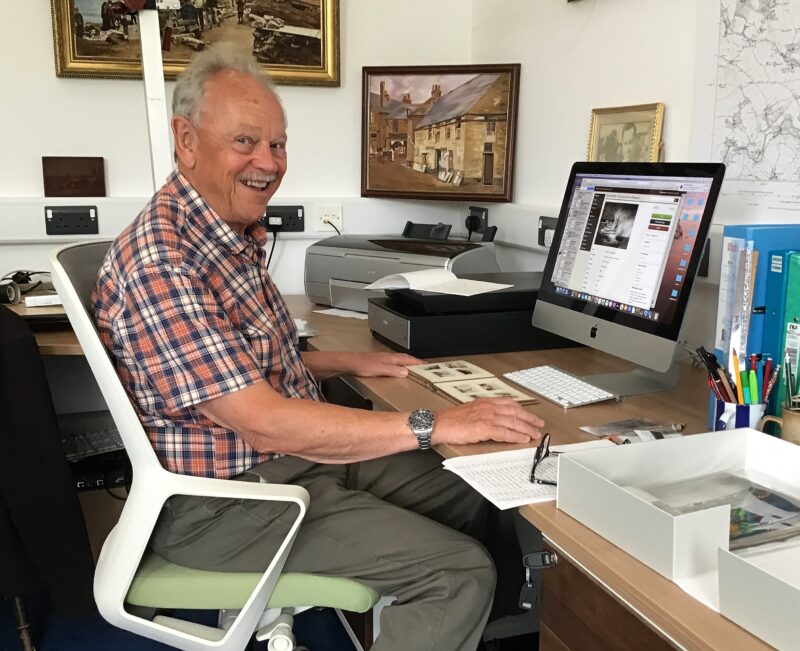
I volunteer in the photo archive as part of a team and see this as a great privilege to work in this wonderful library. This work is like no other; there is no pressure other than to carry out the task with great care, archive many photos, negatives and slides so that they are preserved forever. Preservation sleeves are used to protect them before they are put into conservation boxes for storage.
The room that I work in is new with views across the gardens – a lovely environment. As I sit at my desk, I have a PC and a scanner which must talk to one another if the photo is to arrive in its place in the digital collection. Once logged on then the process begins. This involves allocating a collection number to the photo before it is scanned. The computer programme allows me to add the data such as description, date, location, name of person or group. If it is a ship then the name and date is useful information. A facility also allows me to pinpoint the location on a map if known.
This is the easy part if the information pre-exists but often the process involves searching like a detective to identify the aforementioned essentials. I use books and the internet but there are also many photos in albums which have information about places and dates. All of this takes time but is very enjoyable. If the photographer is named then a search can provide interesting information about their work which is then added.
Fashions in clothing are always changing and it is interesting whilst compiling a collection, to note how fashion changed from the Victorian age and into the Edwardian era. Clothing becomes lighter and less dark and heavy. Women must have found life much easier. It is fascinating to find a detail written on the back of a photo, perhaps a date or a message to the recipient often encountered.
Currently I am working on a collection of miscellaneous photographs which are quite small, in an album with no information whatsoever. I had two photographs of a ship which, through using a magnifier I was fairly sure was in Penzance moored along the quay and the same ship in another photo moored alongside buildings. I needed to find out about this ship so I spent time at home searching for three-masted cargo ships with a white hull. Eventually I found information which identified it as the Leon Burau shown below. Using a magnifier, I identified the ship from the rigging and the shape around the bow. The additional information about the ship was then added to the data page, which will soon appear on the record accompanying the image on our website. Its story is fascinating and a summary follows below.
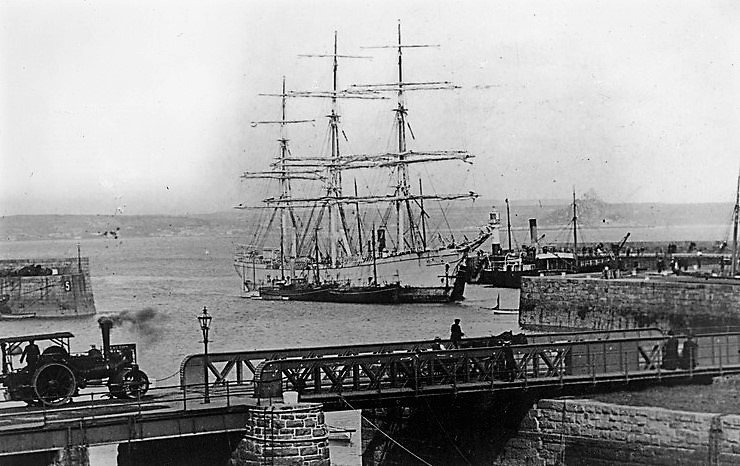
Morrab Library image: HARB 14HF 053
On the 18th of June1909 Alfred Vingoe was returning to Penzance in his pilot boat when he noticed that a large sailing ship was low in the water and flying distress flags. He and his two crew members sailed over to the craft which was the “Leon Burau” to find that the ship had been holed on a rock off the Scilly Isles and was fast taking in water. Climbing aboard Alfred told the captain to put on full sail, and when this was done Alfred piloted the ship into Penzance where he beached her just outside the harbour. The next day was a Sunday and people were amazed to see this fully rigged sailing ship ashore just outside the harbour entrance. Alfred arranged for most of the cargo to be discharged into small ships and then at high tide the ship was towed into the harbour to be repaired. A full account of the rescue is given in the “Cornishman” newspaper.
I was then able to identify that the ship in my photo was moored opposite what is now the dry dock in the harbour.
Just to add more interest an unidentified painting of this ship hangs in the photo archive painted by the Morrab Library benefactor Denis Myner. Further research identified the painting from an original photo as being part of the Richards collection. I then added the information to that photo on its web page identifier.
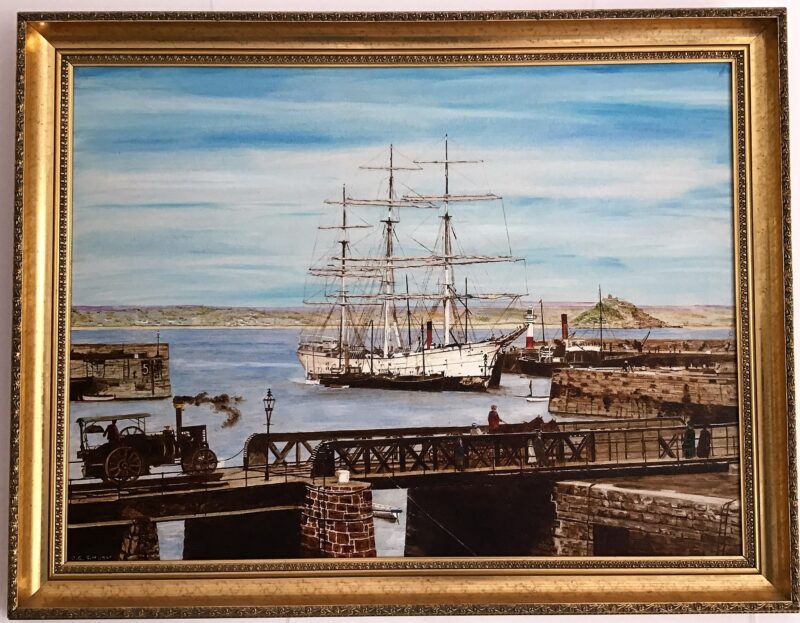
Painting by Denis Myner.
This is just one example of identifying a photo.
At the end of the day, I am usually left with a feeling of satisfaction in having made good progress but also knowing that many interesting searches lie ahead.
David Sleeman
If David’s blog has inspired you to consider volunteering with us in the Photo Archive, please get in touch with the library. You can email photoarchive@morrablibrary.org.uk or call the library on 01736 364474.
by Lisa Di Tommaso | Nov 14, 2019 | Blog, Events, News, Photographic Archive
Don’t forget our Christmas Craft Fair will be held this Saturday from 10.30 am to 2.00 pm. We will be jam-packed with stalls showcasing a variety of beautiful crafts including ceramics, knits, cards, art, woodwork, books and more. Images from our Photo Archives will also be on sale. First prize in our raffle is a wonderful Christmas cake and we’ll have a Tombola too. And of course, our delicious refreshments will be available to enjoy. We really hope to see you there.
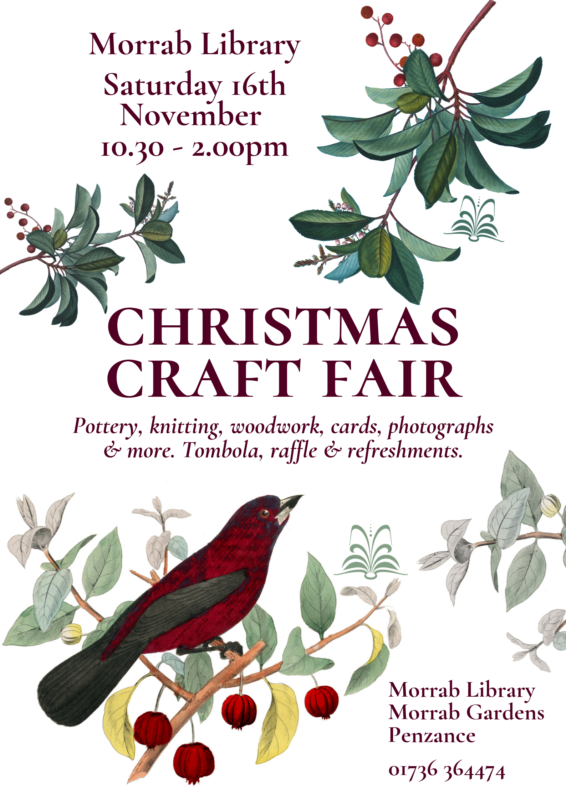
by admin | Apr 25, 2019 | Blog, Photographic Archive
 The Photographic Archive is one of the treasures of Morrab Library. Run by a team of volunteers, it is open to the general public, at no charge, every Thursday morning. Several donated collections form the archive of 15,000 glass and celluloid negatives, and black and white prints. They capture images of life in West Cornwall, and beyond from the early days of photography in the mid-19th century until the late 1970’s. Subjects range from studio portraits to sport, fishing to flower-picking and shops to shipwrecks. A digitisation project is currently underway – more information can be found here: https://morrablibrary.org.uk/photo-archive/
The Photographic Archive is one of the treasures of Morrab Library. Run by a team of volunteers, it is open to the general public, at no charge, every Thursday morning. Several donated collections form the archive of 15,000 glass and celluloid negatives, and black and white prints. They capture images of life in West Cornwall, and beyond from the early days of photography in the mid-19th century until the late 1970’s. Subjects range from studio portraits to sport, fishing to flower-picking and shops to shipwrecks. A digitisation project is currently underway – more information can be found here: https://morrablibrary.org.uk/photo-archive/
Lesley Billingham, one of our Photo Archives volunteers has written a short history of photography, to provide some background and context to the amazing images we hold in our collections……
From the earliest days of humankind people must have seen, by accident, when the sun was at the ‘right’ angle, the dwelling in darkness, a chink in the door; suddenly the scene outside projected, in colour, upside-down on the inside wall. A vision, an image, a mystery.
We have to fast-forward millennia, because very little information exists until this phenomenon became a drawing aid to painters in the 15th century. Leonardo Da Vinci described the principle, “Light entering a minute hole in the wall of a darkened room forms on the opposite wall an inverted image of whatever is outside”. A camera obscura, literally a ‘dark room’. Polished convex mirrors were used and then lenses to sharpen the image. The paintings from this era onward show a significant change in perspective, flat two dimensional images replaced by a more naturalistic three dimensional perspective, just like a photograph.
Experiments in the early 18th century by German physicist Johann Heinrich Schultz established the light sensitivity of silver halide salts, the first glimmer of things to come. In the early 19th century, powered by the industrial and scientific revolutions, came a flurry of excitement around making a photograph that would not fade. In England Thomas Wedgewood, son of the potter Josiah Wedgewood, reported his experiments in recording images on paper or leather sensitised with silver nitrate; he could record but not make them permanent.
In 1802 the famous scientist and poet Humphry Davy, published a paper in The Journal of the Royal Institute on the experiments of his friend Wedgewood, “An Account of a Method of Copying Paintings upon Glass, and of Making Profiles, by the Agency of Light upon Nitrate of Silver, with observations by Humphry Davy. Invented by T. Wedgwood, Esq.” This is the first known account of an attempt to produce a photograph. How exciting to think that the invention of photography was described by a man born and raised in Penzance, who may have even visited the nascent Morrab Library.
Ultimately William Henry Fox Talbot, an English mathematician and scientist using ‘fine writing paper’, sensitised with silver nitrate and fixed with a sodium chloride solution, produced a photograph, but this was only stable for a short while due to inadequate fixing. When his friend, the astronomer Sir John Herschel, suggested fixing the negatives with sodium hyposulphite the images did not fade. We still use ‘hypo’ or ‘fixer’ in modern darkrooms. Meanwhile, in 1826 Nicephore Niepce, an amateur inventor, made the first known photograph, with an exposure of eight hours, of the view from his window at Gratz. Louis Jaques Mande Daguerre, a French scene painter, formed a partnership with Niepce in 1829, but Niepce died four years later, and building on his partner’s work Daguerre managed to make and ‘fix’ images using a much shorter exposure time. This became the daguerreotype process created on a polished metal plate sensitised with silver and developed with mercury vapour, a very toxic process.
Fox Talbot, aware of Daguerre’s work in France, hurried to complete his process and both the daguerreotype and Talbot’s salted paper prints, later renamed the calotype, were formally announced in 1839. The daguerreotype was known as, ‘the mirror with a memory’, and created the most beautiful, extraordinarily detailed images, but being made on a metal plate, each was unique and not reproducible. The calotype, however was made from a paper negative which could be printed many times, although without the sharp detail of the daguerreotype. In 1851 Frederick Scott Archer, a sculptor, invented a method of sensitising glass plates with silver salts by the use of collodian. Within a decade collodian plates completely replaced both the daguerreotype and calotype processes, reigning supreme in the photographic world until the 1880s.
In 1857 cartes de visite were introduced to England. A camera with multiple lenses created a sheet of portraits which could be cut up and presented to your friends. However it was not until J.E. Mayall took carte photographs of Queen Victoria and her family in 1860 that the carte de visit collecting craze exploded. Celebrity cartes were sold in stationer’s shops, just like picture postcards today. These would be collected and mounted in albums, remaining a popular format until the beginning of the 20th century.
This is where our collection begins. The oldest images held here in the Morrab Library Photographic Archive are in an album from the 1860s, containing many cartes de visite of the great and the good of Penzance. These photographs have been carefully collected with hand written titles, many family names are still present in this area today. There are one or two photographs of elderly people in the album and we find ourselves gazing into the eyes of someone born in the 18th century.
Many processes were invented in the following years, the woodburytype, tintype, ambrotype, cyanotype and many more. The new technology of photography required the mass production of materials. Albumen, from millions of hen’s eggs, was used in the manufacture of printing paper. Silver halide salts were mixed with the albumen, spread on paper and dried to form the light sensitive layer. Later, gelatine became more commonly used for this purpose. In the 1880’s an American, George Eastman developed a camera complete with a roll of film, made of celluloid, a kind of early flexible plastic. It is believed that Eastman invented the name Kodak using a word game, but I prefer the idea that ‘Kodak’ mimics the sound made by the shutter, ‘click click’, ‘Kodak’. Moving images followed, then colour images, autochrome, gum bichromate prints created with three layers of light sensitive emulsion. The first world war saw the demise of many of the photographic processes of the 19th century, and for most of the 20th century the silver bromide gelatine based photographic materials have prevailed, but we still use chemistry that William Henry Fox Talbot would recognise in film and paper processing today.
The cave became the camera obscura, the dark ‘room’ used in the 15th century, shrinking first to a wooden box in the 19th century, then a tiny space behind the lens in the miniature cameras of the 20th century, and now in the 21st century a virtual space, an electronic image, created with a lens, but the camera, the ‘room’, no longer real. Even the metallic click of the shutter on the cameraphone is a gratuitous noise, there is no shutter to click.
There is still one mystery; Why did it take so long to capture the image first seen in the cave?
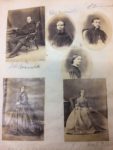 Some Cartes de Visite from the Morrab collections
Some Cartes de Visite from the Morrab collections
by Tom Goskar | May 20, 2016 | Photographic Archive
In March we blogged about our progress with the Stanley Opie archaeology collection. It is a wonderful collection of 1001 photographs, mainly glass negatives, covering archaeological and cultural subjects across Cornwall from the late 1920s to late 1930s. The project was kindly funded by Cornwall Heritage Trust.
We are pleased to announce that we have now digitised the entire collection and it is available to browse and search.
All of the negatives have been conserved and repackaged, going from rows like this:
To digitised files with the negatives packaged like this:
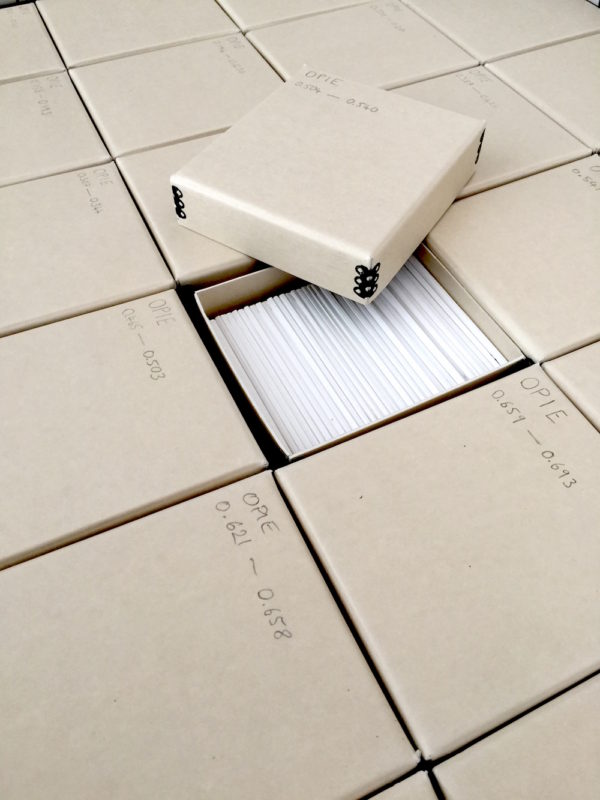
The conservation work on the negatives and their new packaging will ensure that each photograph will be in the best possible condition for many years to come. Each negative is now within its own acid free ‘enclosure’ – a slim box – and then 35 or so of these in a row in a larger archive box. This removes any pressure on the negatives themselves.
The digitised files will be more accessible and reduce or even remove the need to handle the originals other than for condition checks. Our digitised master scans of each of the photographs contain enough detail to resolve the film grain on the negative, ensuring that we have captured all of the detail. This is true of all our digitisation activities.
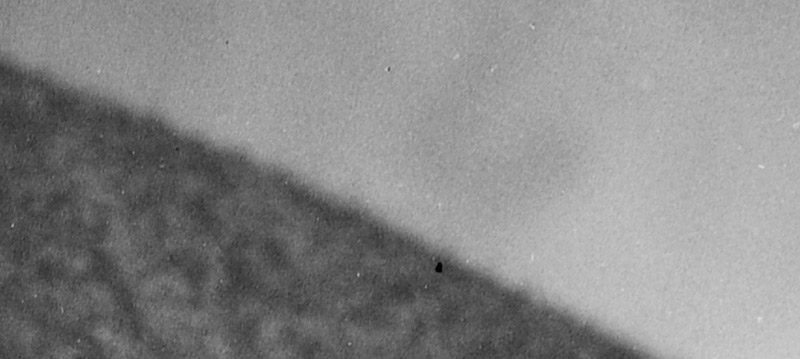
Extract at 100{defc6c7fbd01d59d7a37bb232e5984102f59d6325dfae2b611b202327c53c2bb} from the corner of a photograph showing the original film grain.
There is still work to be done, not least updating the catalogue entries, many of which are brief in the extreme. We will also be editing the “scan masters” to create copies which have been cropped and enhanced. This will be done over the coming months and we ask anyone with extra information about any of the photographs to get in touch with us.
The photographs themselves are fantastic; a real insight into the archaeology of Cornwall in the 20s and 30s. Here are some of the highlights:
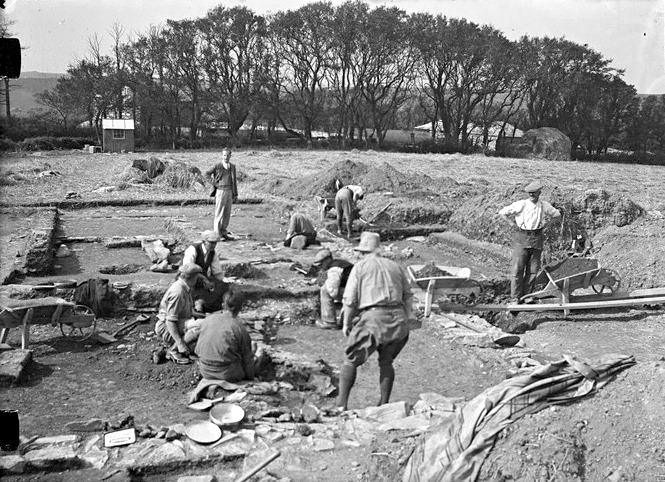
Excavation, Magor Farm Roman Villa, 1932
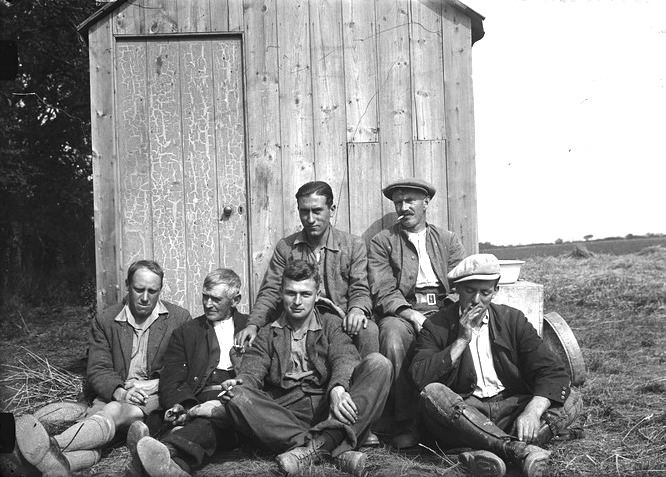
Excavation team, Magor Farm Roman Villa, 1932
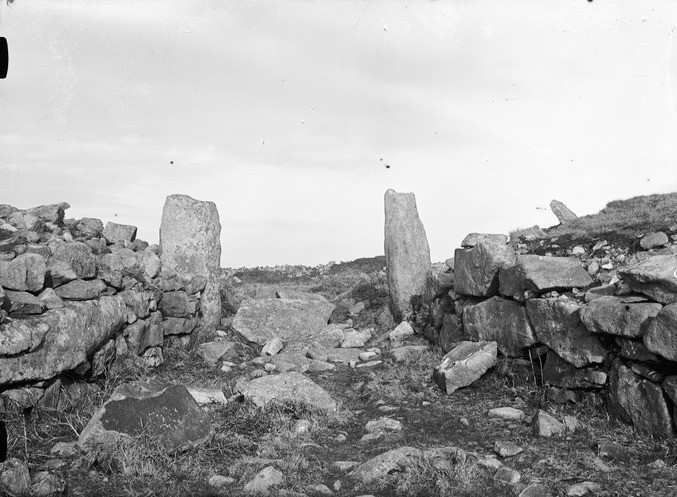
The gateway at Chûn Castle, 1930s

Excavations at Tintagel, 1930s (O.193)
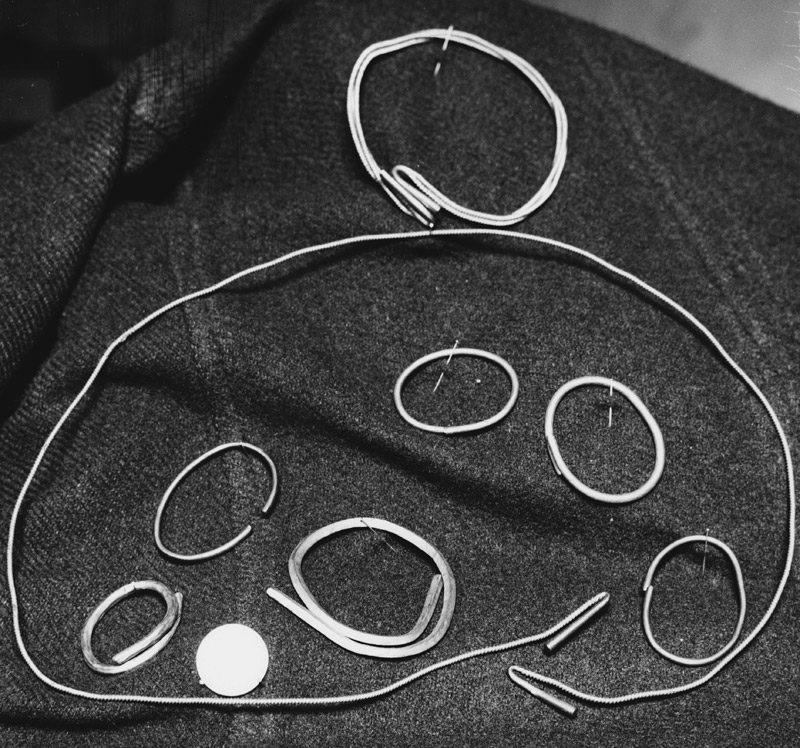
The Towednack Gold Hoard as discovered in December 1931 (O.58)
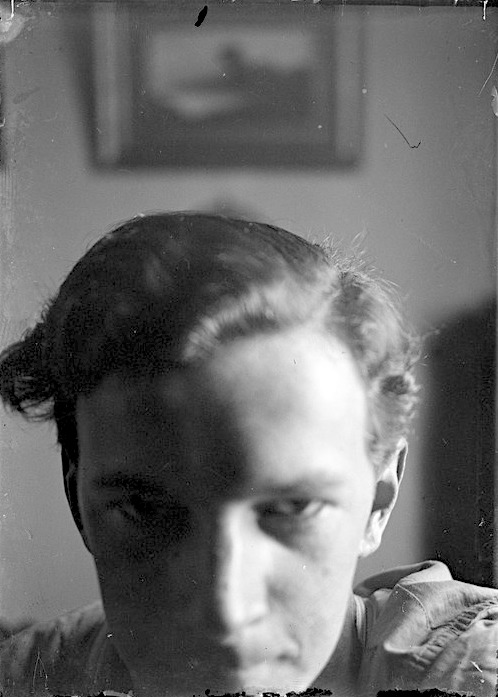
Selfies aren’t as recent a phenomena as we may think. Is this Stanley Opie taking his own photograph? (O.510)
You can view and browse all photos from the Stanley Opie Archaeology Collection and search them on our Photographic Archive catalogue.
The Morrab Library would like to extend great thanks to Cornwall Heritage Trust for funding this project.
by Tom Goskar | Mar 10, 2016 | Photographic Archive
Back in November we announced that we had received a grant from Cornwall Heritage Trust to begin a programme of conservation, digitisation and dissemination of the Stanley Opie collection of archaeology photographs. After a delay while we awaited restocking and delivery of the necessary materials from our conservation supplier, the project has now begun.
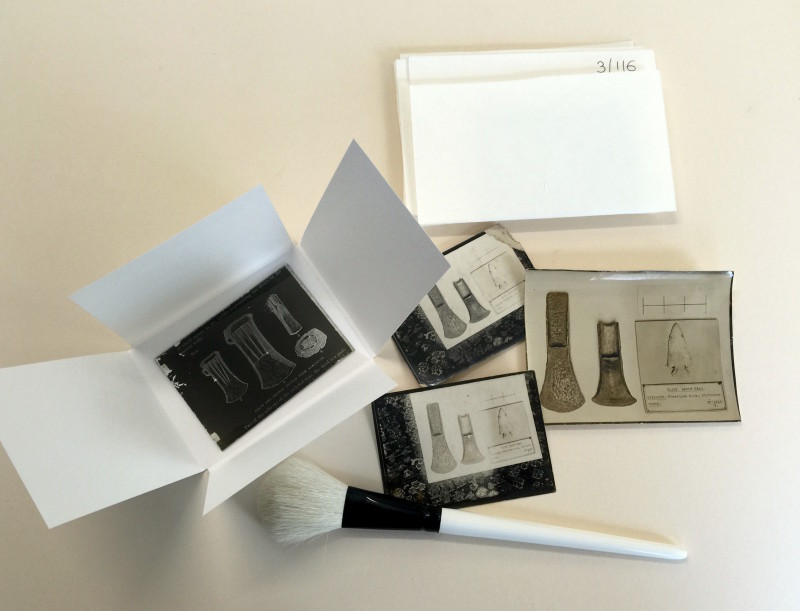
Repackaging glass negatives
The collection of about 1,000 quarter-plate glass negatives (plus a few acetate negatives and positive prints) is being cleaned and repackaged in batches of 50. Each glass plate must first be removed from the old folded card slip, then be inspected. If in a stable condition the glass side is then cleaned with distilled water and a conservation-grade microfibre cloth, before being lightly brushed to remove any loose dust on the emulsion side. Most of the slides are fairly dirty (residue from development, mould from storage), and the difference before and after cleaning is significant. This will mean clearer digitised images, and provide more stability for long term storage of the negative.
The cleaned negative is then placed into a new cruciform negative enclosure. These arrive flat and we must first number and fold them in batches before cleaning commences. The negative in its new enclosure is then placed into a larger box that can accommodate forty of them. The box is then labelled with the collection name and number range contained within.
Each box of negatives is then carefully digitised and the scan is attached to the corresponding record in our photographic database.
This database will soon be available online, and you will be able to browse Stanley Opie’s wonderful and largely unseen photos of Cornwall’s heritage as seen from the 1920s-50s. We plan on releasing regular updates to the database, adding recently digitised images to their catalogue entries.
We are very grateful to Cornwall Heritage Trust for enabling us to undertake this project.
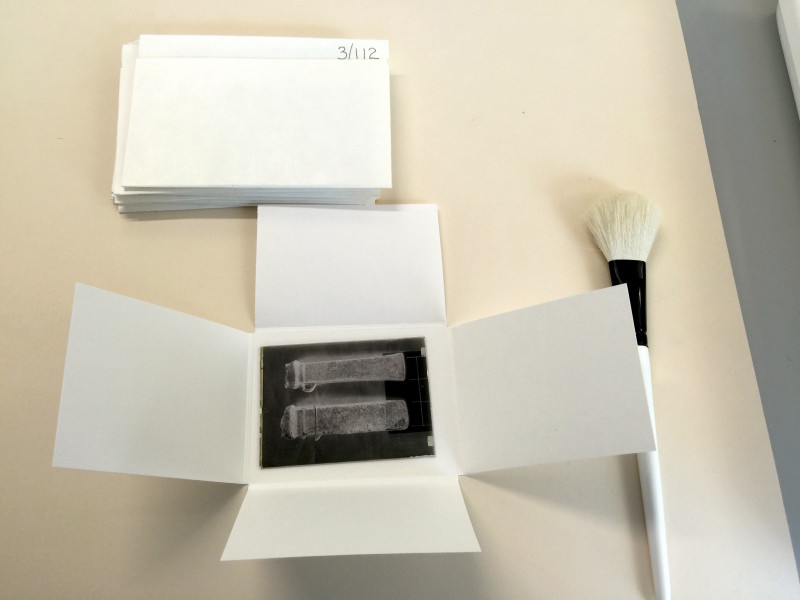
The old cardboard slips and a new glass negative enclosure





 The Photographic Archive is one of the treasures of Morrab Library. Run by a team of volunteers, it is open to the general public, at no charge, every Thursday morning. Several donated collections form the archive of 15,000 glass and celluloid negatives, and black and white prints. They capture images of life in West Cornwall, and beyond from the early days of photography in the mid-19th century until the late 1970’s. Subjects range from studio portraits to sport, fishing to flower-picking and shops to shipwrecks. A digitisation project is currently underway – more information can be found here: https://morrablibrary.org.uk/photo-archive/
The Photographic Archive is one of the treasures of Morrab Library. Run by a team of volunteers, it is open to the general public, at no charge, every Thursday morning. Several donated collections form the archive of 15,000 glass and celluloid negatives, and black and white prints. They capture images of life in West Cornwall, and beyond from the early days of photography in the mid-19th century until the late 1970’s. Subjects range from studio portraits to sport, fishing to flower-picking and shops to shipwrecks. A digitisation project is currently underway – more information can be found here: https://morrablibrary.org.uk/photo-archive/ Some Cartes de Visite from the Morrab collections
Some Cartes de Visite from the Morrab collections








